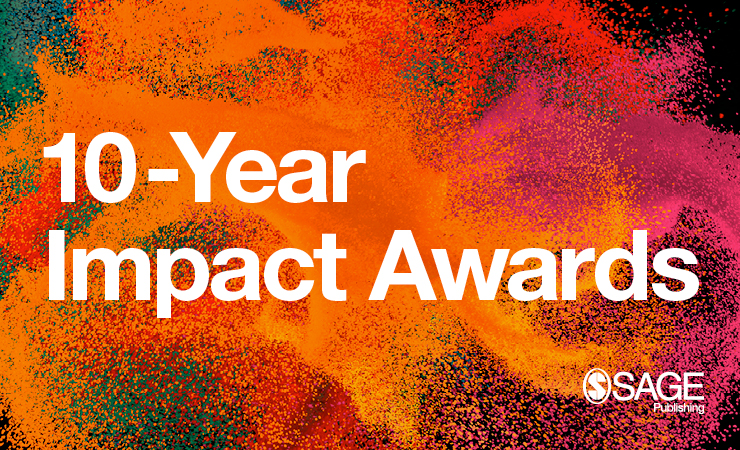Paper on Understanding Individual Differences In Executive Functions Proves Hugely Popular
“Executive function,” whether expressed in that term or more colloquial language, is a psychological subject of huge interest both inside the discipline and — again using more colloquial terms – in the world at large. The authors of the 2012 paper “The Nature and Organization of Individual Differences in Executive Functions: Four General Conclusions” were well aware of this interest – dating back at least to their earlier work in a paper from 2000 – and crafted this paper covering the latest framework to appeal to as wide an academic audience as possible. Their intentions paid dividends, as the paper, published in Current Directions in Psychological Science in 2012, is one of three winners of Sage’s fourth annual 10-Year Impact Awards.
The 10-Year Impact Awards recognize three articles that were published in Sage Journals from a decade ago and have been cited more than any other papers from that year. The executive function paper has been cited 2,172 times.
“These awards were created as part of Sage’s larger effort to inspire and change the conversation around research impact,” said Ziyad Marar, Sage’s president of global publishing. “While a large part of this effort focuses on finding new ways to recognize impact beyond counting citations and outside of academia, the 10-year awards celebrate research with influence that has lasted longer or grown over time.” This longer time frame for a paper to prove influential is common in the social and behavioral disciplines.
Sage asked the authors, Akira Miyake, a professor of psychology in the Department of Psychology and Neuroscience at the University of Colorado at Boulder, and Naomi Friedman, an associate professor in the same department and the Institute for Behavioral Genetics at Boulder, to reflect on their paper and its impact.


(We invite readers to read our conversations with the other two winning author teams, one studying corporate social responsibility and one on online virality, earlier.)
In your estimation, what in your research—and obviously the published paper—is it that has inspired others or that they have glommed onto?
Our 2012 article (published in Current Directions in Psychological Science) is a brief review paper that provided an update of research on executive functions conducted since the publication of the first study we published on this topic back in 2000 (Miyake et al., 2000, Cognitive Psychology). This earlier paper of ours became quite popular, so the impact of our 2012 paper stems in large part from the success of our 2000 paper.
We think that a major appeal of that initial work was that it provided an example framework for examining individual differences in executive functions (abilities to regulate and control one’s thought and action, often associated with frontal-lobe functioning). Although executive functions started to gain popularity in the 1990s, they were difficult to measure with individual tasks, and so was identifying the underlying subcomponents. Such difficulties arise in part because the tasks that are typically used to tap these control processes often also require many other non-control processes that are not of interest but can still contribute to individual differences. Additionally, the wide use of the back-then dominant exploratory factor analysis technique also led to a proliferation of different terms used to interpret the resulting factors derived from a battery of executive function tasks.
The confirmatory factor analytic framework we used in our 2000 study offered one effective solution to both of these problems, because it allowed one to extract common variance across multiple tasks, which is a better measure of executive functioning when the tasks are selected to differ in non-executive demands. It also allowed the advance specification of the underlying subcomponents (e.g., updating, shifting and inhibition in our work) and selection of representative tasks, instead of post-hoc interpretations of what the resulting factors might mean. Over 10 years of work with this framework since 2000 led to the insights that we reviewed in the 2012 paper.
We also believe that our 2012 paper had its impact because it provided substantial updates to our 2000 paper in a concise and accessible manner (only 2,500 words of text, written for a broad audience including advanced undergraduate students, because of the journal’s editorial policy). Theoretically, we described the concept of “general executive function” (called Common EF in the 2012 paper) that was not present in our 2000 paper. Empirically, although our initial study was done with young college students, our research had greatly expanded the scope since. Our 2012 paper briefly summarized the results from various studies that intersected with several major subdisciplines of psychological science (e.g., behavioral genetics, psychopathology and developmental psychology). Demonstrating such a broad applicability of our framework to various research domains also likely contributed to the popularity of our 2012 paper.
What, if anything, would you have done differently in the paper (or underlying research) if you were to go back in time and do it again?
We can point to two things. First, sometimes we have heard other researchers characterize our framework as “the three-factor model,” which may give the impression that all executive function tasks belong to one of these three factors, or researchers may characterize inhibiting, updating and shifting as “core” executive functions, which may give a similar impression. Although we consider the three executive functions we have focused on in our work to be important ones, we never thought that they are the only three functions. We made this point explicitly in our original 2000 paper and then again in our 2012 paper (for example, in our 2012 paper, we said: “…there are other EFs … and other levels of analysis that could be justified and explored,” p. 9). The amount of testing involved in confirmatory factor analysis studies means that only so many tasks can be included within a study before participants get really tired (and even revolt!), but, if that were not an issue, we would have liked to include more constructs and examine different levels of analysis.
Second, when we reread our 2012 paper, what we said about one future research direction—studying influences of individual genes on individual differences in executive functions by conducting simulations—caught our attention. Back then, candidate-gene studies of genetic influences (how different variants of a single gene are associated with individual differences in a psychological function) were still quite popular, but it was already becoming clear that the results of small candidate-gene studies are not reliable and replicable. This makes a lot of sense, given that many, many genes are likely to be contributing to individual differences in any psychological functions. A single gene’s influence on any psychological function is unlikely to be reliably detected in small samples. We had realized this at the time, and that is why we suggested that a promising approach might be to consider aggregate effects of multiple genes.
However, we wish now that our discussion had elaborated on alternative approaches for gene discovery and investigation, particularly genome-wide associations studies, which test every variant across the genome for association with a trait. Genome-wide association studies have recently achieved sample sizes large enough to yield insights into the genetic basis of the Common EF factor (Hatoum et al. 2023, Biological Psychiatry), and one thing that has emerged from this work is the importance of pathways that were not among the usual suspects: specifically GABAergic processes. Had we known what we have learned in the subsequent decade, we would have emphasized the value of hypothesis-free gene discovery and suggested that simulation could be a useful tool for understanding these discoveries rather than just hypothesis generation, as we said in our 2012 paper.
What direct feedback—as opposed to citations—have you received in the decade since your paper appeared?
One of the things we both enjoy so much about studying executive functions is how important they are to so many different areas of psychology (e.g., cognitive, developmental, clinical, social, educational). This broad relevance means that we hear about the importance of executive functions from researchers across many areas of psychology and outside of psychology. Many of such conversations have led to fruitful collaborations to study implicit racial bias, sleep problems, creativity, acute effects of alcohol on executive functions and individual differences in sentence processing.
We have also been invited to various symposia, workshops and colloquium talks to present our work on executive functions. On such occasions, it is often the case that we get questions about some topics that we have not studied ourselves and therefore have not thought too much about (e.g., training of executive functions, impacts of bilingualism or music training on executive functions, best ways to study executive function impairments in special populations, educational implications of individual differences in executive functions). It has been a pleasure to be able to have such interesting conversations with other researchers.
How have others built on what you published? (And how have you yourself built on it?)
In our 2012 paper, we discussed four general conclusions involving (a) the unity and diversity of executive functions, (b) their genetic influences, (c) their relevance to clinical and societally relevant outcomes and (d) developmental stability. We and others have followed up on all of these lines of research.
For example, the unity and diversity of executive functions (the idea that different types of executive functions share some underlying commonality but are also separable) has been studied in the context of neuroimaging studies, both by our group and by other researchers. Genetic influences have been examined using a genome-wide association study, as we already mentioned earlier. Examples of work illustrating clinical and societal relevance of executive functions include studies of internalizing psychopathology (e.g., depression, anxiety) as well as externalizing psychopathology (e.g., substance use), repetitive negative thinking (e.g., rumination, worry), procrastination and implicit racial bias, just to name a few. Finally, we have also examined longitudinal stability—and also changes—in the structure of individual differences in executive functions at both phenotypic and genetic levels. Others have examined the factor structure of executive functions among children and also among older adults.
At the same time, executive function research since the publication of our 2012 paper has raised various new important questions that must be addressed. For example, there is a renewed interest in the measurement of executive functions. In particular, the question of whether commonly used measures of inhibition indeed tap some common underlying ability has become a controversial issue. Another measurement-related issue that has become particularly salient recently concerns the relationship between executive functions as measured with laboratory tasks (our focus in our 2012 paper) and those as assessed with questionnaires (Friedman & Gustavson, 2022, Current Directions in Psychological Science). More recently, there have also been attempts to reconceptualize executive functions, especially from a developmental perspective. These are all interesting new directions in executive function research that we believe have been inspired in part by the work we have published.
Could you name a paper (or other scholarly work) that has had the most, or at least a large, impact on you and your work?
Our initial 2000 work was inspired especially by two studies. First, John Duncan’s work on frontal lobe functions, especially Duncan et al. (1997), entitled “Frontal lobe deficits after head injury: Unity and diversity of function” (published in Cognitive Neuropsychology), introduced us to the notion of unity and diversity (Duncan’s work was in turn inspired by Teuber’s even earlier paper published in 1972, entitled “Unity and diversity of frontal lobe functions”). Second, Randy Engle’s group’s work about the relationship between short-term memory and working memory capacities (Engle et al., 1999, published in Journal of Experimental Psychology: General) was our first introduction to a confirmatory factor analysis approach to studying individual differences in cognitive abilities. Our 2000 study essentially combined the ideas of these two earlier studies.
In developing our thinking about the nature of a general executive function factor (Common EF) described in our 2012 paper, we were strongly influenced by Miller and Cohen’s (2001) classic review (published in Annual Review of Psychology). In fact, the important role of goal maintenance in attentional control was highly salient when Miyake was a graduate student at Carnegie Mellon University, where Jonathan Cohen was a faculty member at that time. Other faculty members’ theoretical thinking also emphasized the importance of goal management and maintenance in complex cognition. Being exposed to such ideas repeatedly during graduate training no doubt contributed to our conceptualization of the general executive function factor, which we already mentioned speculatively in our 2000 paper.

























































































Greetings Sage Publishing,
I would like to recommend a similar award system for social science research and theory building (separately) publications in developing countries. You can even establish a committee to develop criteria and evaluate submitted publications,